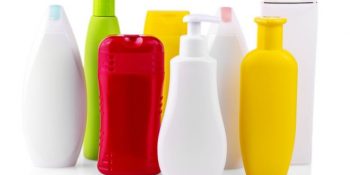Chemical products that contain compounds refined from petroleum, like household cleaners, pesticides, paints and perfumes, now rival motor vehicle emissions as the top source of urban air pollution, according to a surprising NOAA-led study by researchers from the University of Colorado Boulder and other institutions.

People use a lot more fuel than they do petroleum-based compounds in chemical products—about 15 times more by weight, according to the new assessment. Even so, lotions, paints and other products contribute about as much to air pollution as the transportation sector does, said lead author Brian McDonald, a scientist at the CU Boulder-based Cooperative Institute for Research in Environmental Sciences (CIRES) working in the National Oceanic and Atmospheric Administration (NOAA) Chemical Sciences Division.
In the case of one type of pollution—tiny particles that can damage people’s lungs—particle-forming emissions from chemical products are about twice as high as those from the transportation sector, his team found. McDonald and colleagues from NOAA and several other institutions reported their results today in the journal Science.
As transportation gets cleaner, those other sources become more and more important. The stuff we use in our everyday lives can impact air pollution. — McDonald
For the new assessment, the scientists focused on volatile organic compounds or VOCs. VOCs can waft into the atmosphere and react to produce either ozone or particulate matter—both of which are regulated in the United States and many other countries because of health impacts, including lung damage.
Those of us living in cities and suburbs assume that much of the pollution we breathe comes from car and truck emissions or leaky gas pumps. That’s for good reason: it was clearly true in past decades. But regulators and car manufacturers made pollution-limiting changes to engines, fuels and pollution control systems. So McDonald and his colleagues reassessed air pollution sources by sorting through recent chemical production statistics compiled by industries and regulatory agencies, by making detailed atmospheric chemistry measurements in Los Angeles air, and by evaluating indoor air quality measurements made by others.
The scientists concluded that in the United States, the amount of VOCs emitted by consumer and industrial products is actually two or three times greater than estimated by current air pollution inventories, which also overestimate vehicular sources. For example, the Environmental Protection Agency estimates that about 75 percent of fossil VOC emissions (by weight) come from fuel-related sources, and about 25 percent from chemical products. The new study, with its detailed assessment of up-to-date chemical use statistics and previously unavailable atmospheric data, puts the split closer to 50-50.
The disproportionate air quality impact of chemical product emissions is partly because of a fundamental difference between those products and fuels, said NOAA atmospheric scientist Jessica Gilman, a co-author of the new paper.
Gasoline is stored in closed, hopefully airtight, containers and the VOCs in gasoline are burned for energy. But volatile chemical products used in common solvents and personal care products are literally designed to evaporate. You wear perfume or use scented products so that you or your neighbor can enjoy the aroma. You don’t do this with gasoline. — Gilman
The team was particularly interested in how those VOCs end up contributing to particulate pollution. A comprehensive assessment published in the British medical journal Lancet last year put air pollution in a top-five list of global mortality threats, with “ambient particulate matter pollution” as the largest air pollution risk.
The new study finds that as cars have gotten cleaner, the VOCs forming those pollution particles are coming increasingly from consumer products.
We’ve reached that transition point already in Los Angeles. — McDonald
He and his colleagues found that they simply could not reproduce the levels of particles or ozone measured in the atmosphere unless they included emissions from volatile chemical products. In the course of that work, they also determined that people are exposed to very high concentrations of volatile compounds indoors, which are more concentrated inside than out, said co-author Allen Goldstein, from the University of California Berkeley.
Indoor concentrations are often 10 times higher indoors than outdoors, and that’s consistent with a scenario in which petroleum-based products used indoors provide a significant source to outdoor air in urban environments.”
The new assessment does find that the U.S. regulatory focus on car emissions has been very effective, said co-author Joost de Gouw, a CIRES chemist.
It’s worked so well that to make further progress on air quality, regulatory efforts would need to become more diverse. It’s not just vehicles anymore. — de Gouw
CIRES is a partnership of NOAA and the University of Colorado Boulder.
SPREAD THE NEWS
COMMENT, Like, Follow & SHARE @I70Scout
CURRENT EDITION
WEATHER & TRAFFIC PUZZLES RECENT NEWS ADVERTISE WITH US

Leave a Reply